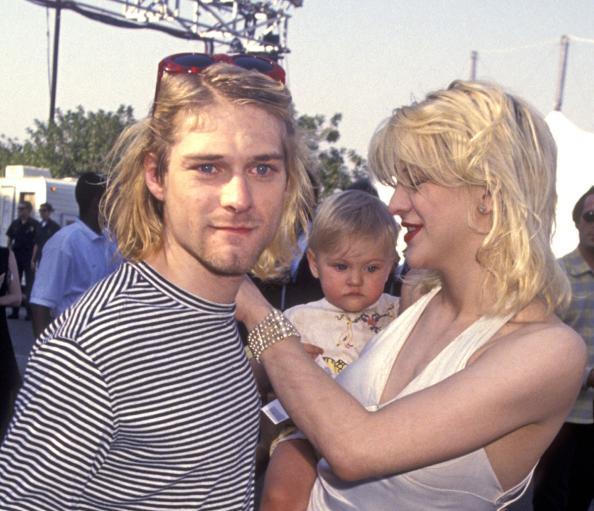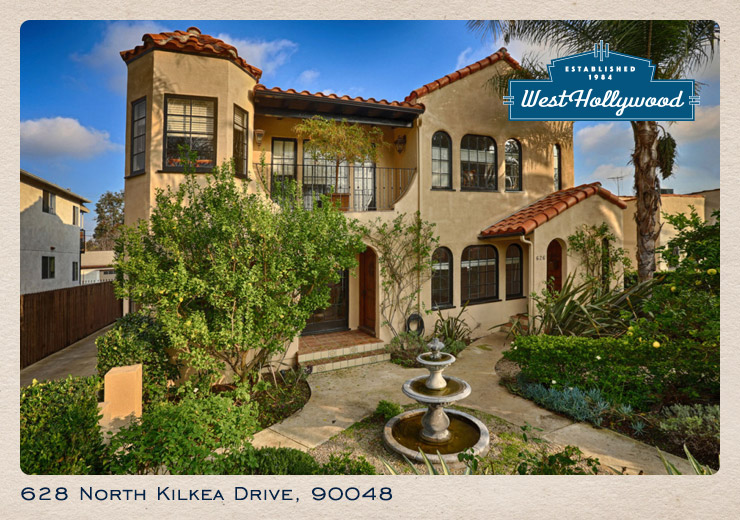This stunning 1926 Spanish duplex features original detailing, updated modern conveniences and a very spacious floor plan. Elegant and inspired, 628 North Kilkea displays its pedigree with characteristic stucco walls, red clay tile roof, sweeping archways, and a private courtyard. Its romantic appeal blends Mediterranean, Moorish and Spanish Colonial. All this, within steps to arguably the city’s best shopping boutiques, and the venerable Fairfax Village for eats and culture.

Photo courtesy of amoeba.com
There was plenty of grumbling out west when Forbes magazine anointed eastside’s Silver Lake LA’s Best Hipster neighborhood. Perhaps there’s so much about the Fairfax District to extol that it was time to throw the dart at the map. But for the record, all things material, Fairfax Village is King.
When it comes to shopping, the neighborhood doesn’t slouch–unless it’s deemed fashionable, that is. Just around the corner from 628 N Kilkea, Fred Segal, cloaked in creeping fig vine, leads the pack in the art of retail. As a young entrepreneur in 1961, founder Fred Segal unleashed the first wave of designer denim mania–when jeans were retailing for $3.98, he priced his at $19.95–and promptly had customers lining up around the block. He saw potential in the blue jean business, opening a novel denim bar concept that retailers such as Gap and Macy’s have since embraced.

Fred Segal unique exterior covered in creeping fig vine. Near the corner of Melrose and Kilkea. Photo courtesy Tripadvisor: Photograph: Celebrityhomephotos. (Newscom TagID: pacificphotos078118) [Photo via Newscom]
“What truly made him a retail visionary, though, was pioneering the shop-in-shop concept that is now standard practice in department stores. Segal served as the original savvy landlord, clustering a highly curated collection of cutting-edge, independent retailers inside his ivy-covered walls, first on Melrose in 1965, and later on Broadway in Santa Monica. With their ability to spot the next big thing, those deputized curators of cool — Ron Herman and Ron Robinson among them —– helped establish Segal’s centers as retail must-visits. And, as a de facto extension of the wardrobe departments for many a fashion-influencing TV show (“Melrose Place” and “Friends” among them), the centers helped define a certain brand of SoCal style that’s now as common a sight in Montmartre as it is in Malibu.” Has Fred Segal gone from L.A. cool to tepid with moves to LAX, Vegas? By Adam Tschorn, September 5, 2014
With the neighborhood pop up businesses, clothing and shoe boutiques, restaurants like Animal — and right alongside it, holdovers from old LA such as Canter’s, Fairfax has been compared to New York’s East Village.

Canter’s Deli-voted the best pastrami by the LA Times and LA Weekly. This old kosher deli is open 24/7. People come in droves for their huge sandwiches, low prices and sometimes rude service. Over the years they’ve served over 20 million bagels, and have seen more than their share of celebrities from Marilyn Monroe, and Elvis to today’s Hollywood set.
Fairfax Village owns the update on hip, however, with Huffington Post dubbing Fairfax LA ’s Coolest Street:
“More recently, though, it’s the neighborhood’s restaurant scene that’s been attracting attention. The drag started to become a culinary hot spot around 2008, when Starr, a former advertising executive, opened burger joint The Golden State and star chefs Jon Shook and Vinny Dotolo opened their first restaurant, the meat-focused Animal, on the block between Rosewood and Oakwood. Today, new restaurants seem to open almost every month. Even celebrated chef Michael Cimarusti, of LA fine-dining temple Providence, plans to open a fish shop on the street.” How Fairfax Became The Coolest Street In Los Angeles, Joe Satran, February 2, 2015

“Meet me on 3rd and Fairfax” was once a common expression among Angelenos – and with good reason. At the corner of 3rd and Fairfax you’ll find both the Farmers Market, first opened in July 1934, a historic LA landmark area of food stalls, sit-down eateries, prepared food vendors, and produce markets, and the retail and entertainment complex, The Grove, built by Rick Caruso and company. Both are must-see destinations that together offer an abundance of dining, shopping and entertainment options.

Though two separate entities, Farmers Market and The Grove have a strong synergy. On any given day, there is a constant stream of visitors (and celebrities) strolling to and from the two attractions. An electric trolley is even on-site to shuttle the less mobile between The Grove and the Farmers Market.

CBS Television City looms to the north, one of two CBS television studios in southern California—the other being CBS Studio Center in Studio City. Since 1961, CBS Television City has served as the master control facility for CBS’s west coast television network operations.
Interestingly, both CBS Television City, and The Grove, were built on the site of a former football field and race track, Gilmore Stadium. Before the stadium, it was an oil field.

Gilmore Stadium opened in May 1934 with a capacity of 18,000. Next to it was Gilmore Field, It was located next to Gilmore Field which opened on May 2, 1939 and was the home of the Hollywood Stars of the Pacific Coast League until September 5, 1957. The stadium had a seating capacity of almost 13,000.
The stadium was built by Earl Gilmore, son of oil baron, Arthur F Gilmore the president of A. F. Gilmore Oil. His company was founded after Arthur struck oil on the family property. The area was rich in petroleum, as evidenced in the nearby La Brea Tar Pits.

Before there were Dodgers, Lakers, or Kings in Los Angeles, let alone Dodger Stadium, LA’s Sports Arena, or Forum, Gilmore Stadium ran midget races on its quarter-mile oval from 1934 to 1950. It was in the years before World War II, when racing flourished.

At the Passing of Mini Race Car Driver, Sam Hanks, in 1994 the LA Times wrote:
“But it was the “mighty midgets,” as they were known in the ’30s and ’40s, that were headline news when they raced every Thursday night. In 1937, the year Hanks won the track championship, capacity crowds of 18,000 were on hand through the summer at Gilmore Stadium.
For a few years, it was possible to watch midget racing every night of the week–at Atlantic Speedway in South Gate, Culver City, Huntington Beach, Loyola, Colton, San Bernardino, Balboa Stadium in San Diego, and on occasion, the Coliseum and the Rose Bowl.
In 1947, a midget-record 65,128 spectators were at the Coliseum when Hanks out-drove Duke Nalon, Duane Carter, Mack Hellings and Bob Pankratz in winning a 250-mile race on a board track.” LA Times, Hanks’ Death Ends Golden Era of Midget Racing, July 7, 1994

You can see Gilmore Stadium featured in a 1934 Three Stooges short featuring a football game, and fittingly titled Three Little Pigskins. The scoreboard, with the name of the stadium, appears prominently in several shots, as does a billboard advertising Gilmore products. A sign for the nearby Fairfax Theater, across Beverly Boulevard at the north (open) end of the stadium, is also visible in the background a couple of times. Gilmore Stadium was demolished in 1952, to make way for CBS Television City.

628 North Kilkea still has plenty of entertainment to offer, not least of which is the L.A. Improv within walking distance.

And after you’ve enjoyed the local restaurant scene and a shop-til-you-drop day, 628 North Kilkea is a veritable oasis to come home to.

There’s good reason why Spanish revival homes fit so well into the Los Angeles’ temperate climate: oh so cool interiors.




Enter through the lushly landscaped courtyard past a welcoming fountain, both of which immediately immerse you in peace as you come in off the street.

Abundant natural light, with large open dining and living rooms. Saltillo tile gleams throughout.

Generous sized kitchen with stainless steel appliances, granite counters, and a charming breakfast nook.






Two large bedrooms with One and 3/4 baths. This private outdoor retreat is off the large master suite.

If you are looking for furniture for your home or simply want to be inspired by some great design, you need only go steps away from 628 North Kilkea to find Beverly Boulevard, L.A.’s premier boulevard for mid-20th-century furnishings.

Expensive showrooms line Beverly Boulevard from La Brea Ave. to Robertson Blvd. But don’t stop there, Robertson Boulevard is a favorite shopping mecca for celebrities, paparazzi who stalk them, and star gazers.
You’ve seen the full buffet of what celebs love about the neighborhood, but maybe you’d like an actual taste of what it’s like to live like a rock star.
Now fans of the late Kurt Cobain have a new, even more intense way to experience the Nirvana icon’s life: the Los Angeles apartment he shared with Courtney Love from 1991 to 1992 is currently an Airbnb rental.

The apartment, located just a few blocks east of 626 N Kilkea on Spaulding Avenue, is where the grunge couple resided at the height of Nirvana mania while Love was pregnant with Frances Bean Cobain. The current tenant has rented out Cobain and Love’s bedroom on Airbnb for the past couple years. Stories abound, but according to an LA Times article by journalist Charles R. Cross, what used to happen in the apartment was heroin, and painting. While Nevermind was climbing the charts, Cobain turned down offers to tour in favor of creating art in the 1,500-square-foot, two-bedroom, two-bath apartment. Cross writes, “Their time on Spaulding represented his greatest immersion in painting.”
The 2001 Cobain biography Heavier Than Heaven reported that Cobain and Love rented the unit for $1,100 a month, and that Cobain enjoyed making the five-minute walk to eat at nearby Canter’s Deli, maybe he didn’t mind the cranky waitresses!

Leave a Reply
You must be logged in to post a comment.